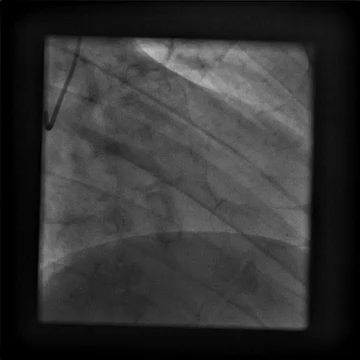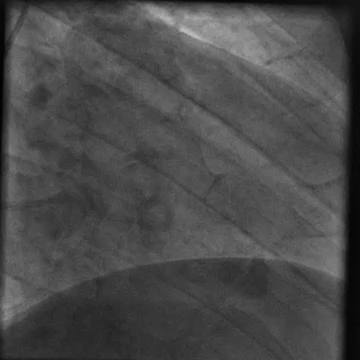Myocardial Bridging in Adults
Quick Takes
- Myocardial bridges are common and generally benign.
- Exercise and tachycardia can provoke symptoms and ischemia.
- The optimal treatment plan should be based on symptoms, the presence of documented ischemia, and the athlete's goals.
Case Presentation
A 66-year-old male rower with a history of hypertension and dyslipidemia presented with exertional chest pain and palpitations. He denied symptoms or limitations with activities of daily living. He engaged in vigorous exercise daily and his goal was to continue his current exercise routine without exercise restrictions.
He underwent a maximal effort exercise stress test that demonstrated increasing ventricular ectopy and runs of nonsustained ventricular tachycardia (NSVT) at higher workloads (Figure 1). An echocardiogram revealed a normal left ventricular ejection fraction (LVEF) of 65% with a left ventricular end diastolic dimension of 50 mm and septal and posterior wall thickness of 12 mm and 11 mm, respectively.
Figure 1
He was referred for a coronary angiogram (Video 1) and underwent intracoronary dobutamine infusion (Video 2) that reproduced his symptoms of chest pain and palpitations, the latter correlated with salvos of ventricular tachycardia.
Video 1
Video 2
Myocardial Bridging
Myocardial bridging occurs when a portion of an epicardial coronary artery takes an intramuscular course and is tunneled under an overlying muscular bridge.1 This congenital coronary anomaly results in systolic compression of the tunneled portion of the coronary artery and remains clinically silent in the majority of cases. While any epicardial artery can be affected, bridging of the middle segment of the left anterior descending (LAD) is most common.2
The prevalence of myocardial bridges varies greatly based on the technique used to identify the anomaly. The prevalence in autopsy studies have been reported as high as 86%,3 with a mean of 25% similar to more recent evaluations using coronary computed tomography angiography (CCTA).4 In contrast, the prevalence of myocardial bridging reported by coronary angiography is lower than autopsy and CCTA studies, ranging from 0.5 to 16%, and remains ≤40% with use of provocative testing.3 There is a high prevalence (41%) of myocardial bridging in adults with hypertrophic cardiomyopathy (HCM).5 Differences in prevalence based on the diagnostic modality used highlight the importance of differentiating a significant functional finding from an anatomic finding.
Pathophysiology
There is evidence of accelerated atherosclerotic plaque formation that develops proximal to the bridged segment but spares the tunneled segment.6 Increases in local wall tension and stretch may induce endothelial injury and contribute to proximal atherosclerotic plaque formation.7,8 However, this fixed proximal plaque is likely not the sole mechanism of myocardial ischemia in these patients.6 Using frame-by-frame quantitative coronary angiography, vessel compression of bridged arteries was shown to extend into diastole resulting in decreased coronary artery perfusion.9,10 Combining intracoronary doppler flow and pressure measurements with coronary angiography, evidence of a persistent decrease in diastolic vessel diameter and reduced flow reserve in patients with symptomatic bridges was demonstrated.7 Given this, ischemia is likely provoked by tachycardia and increased contractility during stress or exercise resulting in decreased diastolic coronary artery filling time, impairment of coronary blood flow and worsening of systolic and diastolic compression of the artery.3 Pathologic studies suggest that bridged vessels that are long and deeper than 3 mm beneath the epicardium are high risk for cardiac events.11
Clinical Presentation
Myocardial bridges have been associated with exertional angina, myocardial ischemia, acute coronary syndromes, ventricular arrhythmias, stress cardiomyopathy, and sudden cardiac death.2 However, these complications are rare and most myocardial bridges are benign and have no clinical significance. Previously asymptomatic patients may develop symptoms with the development of diastolic dysfunction, left ventricular hypertrophy, coronary vasospasm or microvascular dysfunction.2 Additionally, symptoms and ischemia may be provoked by exercise and tachycardia.
Diagnosis
A variety of diagnostic modalities are used to investigate the anatomic and physiologic significance of myocardial bridging. CCTA can be a valuable tool to assess myocardial anatomy and can provide structural information on myocardial bridges. However, subsequent testing is required to assess the functional relevance of findings on CCTA. Thus, coronary angiography is commonly utilized to provide a structural and functional assessment of the bridge. Typical findings include a systolic narrowing or "milking" of the epicardial artery and a "step down-step up" phenomenon that helps identify the tunneled segment. When angiographic diagnosis remains uncertain, intravascular ultrasound (IVUS) has been shown superior at detecting bridging.6 Fractional flow reserve (FFR) may be utilized to better assess the physiologic impact of myocardial bridges. Given the pathophysiology, provocation with dobutamine is preferred over adenosine, and diastolic FFR measurements should be measured instead of mean FFR.12,13 Additionally, intracoronary nitroglycerin may be utilized to accentuate systolic narrowing of the bridged segment, as it will vasodilate adjacent non-bridged coronary segments.14
Treatment
The evidence behind medical therapy in myocardial bridging is limited. Nitrates are contraindicated as they can accentuate systolic compression of the bridged segment by vasodilating the adjacent non-bridged coronary segments and worsen symptoms.6 Calcium channel blockers may be beneficial if vasospasm is present. Beta blockers are thought to relieve hemodynamic disturbances by decreasing peak heart rate, increasing diastolic filling time, and decreasing contractility and compression of the artery.15 As a result, they are commonly used as first line agents for patients with symptoms.
Percutaneous coronary intervention (PCI) for bridging refractory to medical therapy was first reported in 1995.16 Originally thought to resolve hemodynamic abnormalities and symptoms, PCI for myocardial bridging has resulted in high rates of target lesion revascularization6 and concerns of stent fracture, stent thrombosis and coronary perforation. The usefulness of this approach is thus very limited and not recommended.
The two most common surgical approaches are coronary artery bypass grafting (CABG) and surgical myotomy. Given the concern of graft failure, CABG seems to be most beneficial in long (>25 mm) or deep (>5 mm) myocardial bridges.2 In the absence of long or deep bridges, surgical myotomy should be considered. Surgical myotomy involves resecting the overlying muscle fibers of the myocardial bridge and has been shown to increase coronary blood flow and eliminate symptoms.6
Specific Considerations for Athletes
Given the rarity of cardiac events despite a high prevalence of myocardial bridging on autopsy and CCTA studies, providers should be cautious to attribute cardiac symptoms in athletes to a myocardial bridge.17 This may be particularly true in masters athletes that have participated in competitive sport for years without incident and survived the test of time. However, hypertension and attendant development of left ventricular hypertrophy may augment coronary compression and reduce coronary microvascular reserve and provide a potential explanation to why one may become symptomatic later in life.2
Current recommendations suggest that athletes with myocardial bridging and no evidence of ischemia during maximal effort stress testing may participate in all competitive sports.11 In symptomatic athletes, initiation of beta blockers in conjunction with periodic stress testing to assess efficacy may be effective. However, vigorous exercise can increase the risk of adverse cardiac events in those with symptomatic myocardial bridges and documented ischemia, thus a surgical approach may be beneficial in athletes who wish to return to full participation. Ultimately, in the absence of clinical trials to guide the optimal treatment plan, a shared decision-making approach is recommended.
Case Follow Up
Our patient was found to have a hemodynamically significant mid LAD myocardial bridge with 75% stenosis during systole under resting conditions. Given his goal to return to intense exercise training without restrictions and clear evidence of ischemia with dobutamine infusion, it was recommended that he undergo surgical myotomy. He tolerated the procedure well. Repeat exercise testing revealed an appropriate cardiovascular response to exercise without ventricular ectopy, ischemia or chest pain. He remains asymptomatic and is being followed without exercise restrictions.
References
- Angelini P, Velasco JA, Flamm S. Coronary anomalies: incidence, pathophysiology, and clinical relevance. Circulation 2002;105:2449–54.
- Corban MT, Hung OY, Eshtehardi P, et al. Myocardial bridging: contemporary understanding of pathophysiology with implications for diagnostic and therapeutic strategies. J Am Coll Cardiol 2014;63:2346–55.
- Möhlenkamp S, Hort W, Ge J, Erbel R. Update on myocardial bridging. Circulation 2002;106:2616–22.
- Konen E, Goitein O, Sternik L, Eshet Y, Shemesh J, Di Segni E. The prevalence and anatomical patterns of intramuscular coronary arteries. J Am Coll Cardiol 2007;49:587–93.
- Basso C, Thiene G, Mackey-Bojack S, Frigo AC, Corrado D, Maron BJ. Myocardial bridging, a frequent component of the hypertrophic cardiomyopathy phenotype, lacks systematic association with sudden cardiac death. Eur Heart J 2009;30:1627–34.
- Lee MS, Chen C-H. Myocardial bridging: an up-to-date review. J Invasive Cardiol 2015;27:521–8.
- Klues HG, Schwarz ER, vom Dahl J, et al. Disturbed intracoronary hemodynamics in myocardial bridging: early normalization by intracoronary stent placement. Circulation 1997;96:2905–13.
- Ge J, Erbel R, Görge G, Haude M, Meyer J. High wall shear stress proximal to myocardial bridging and atherosclerosis: intracoronary ultrasound and pressure measurements. Br Heart J 1995;73:462–5.
- Ge J, Erbel R, Rupprecht HJ, et al. Comparison of intravascular ultrasound and angiography in the assessment of myocardial bridging. Circulation 1994;89:1725–32.
- Erbel R, Rupprecht H-J, Ge J, Gerber T, Görge G, Meyer J. Coronary artery shape and flow changes induced by myocardial bridging: assessment by intravascular ultrasound. Echocardiography 1993;10:71–7.
- Thompson PD, Myerburg RJ, Levine BD, Udelson JE, Kovacs RJ. Eligibility and disqualification recommendations for competitive athletes with cardiovascular abnormalities: Task Force 8: coronary artery disease: a scientific statement from the American Heart Association and American College of Cardiology. J Am Coll Cardiol 2015;66:2406–11.
- Escaned J, Cortés J, Flores A, et al. Importance of diastolic fractional flow reserve and dobutamine challenge in physiologic assessment of myocardial bridging. J Am Coll Cardiol 2003;42:226–33.
- Hakeem A, Cilingiroglu M, Leesar MA. Hemodynamic and intravascular ultrasound assessment of myocardial bridging: fractional flow reserve paradox with dobutamine versus adenosine. Catheter Cardiovasc Interv 2010;75:229–36.
- Hongo Y, Tada H, Ito K, Yasumura Y, Miyatake K, Yamagishi M. Augmentation of vessel squeezing at coronary-myocardial bridge by nitroglycerin: study by quantitative coronary angiography and intravascular ultrasound. Am Heart J 1999;138:345–50.
- Schwarz ER, Klues HG, vom Dahl J, Klein I, Krebs W, Hanrath P. Functional, angiographic and intracoronary Doppler flow characteristics in symptomatic patients with myocardial bridging: effect of short-term intravenous beta-blocker medication. J Am Coll Cardiol 1996;27:1637–45.
- Stables RH, Knight CJ, McNeill JG, Sigwart U. Coronary stenting in the management of myocardial ischaemia caused by muscle bridging. Br Heart J 1995;74:90–2.
- Gowd BMP, Thompson PD. Isolated myocardial bridging and exercise-related cardiac events. Int J Sports Med 2014;35:1145–50.
Clinical Topics: Acute Coronary Syndromes, Arrhythmias and Clinical EP, Heart Failure and Cardiomyopathies, Invasive Cardiovascular Angiography and Intervention, Noninvasive Imaging, Sports and Exercise Cardiology, Stable Ischemic Heart Disease, EP Basic Science, SCD/Ventricular Arrhythmias, Interventions and ACS, Interventions and Imaging, Interventions and Structural Heart Disease, Angiography, Nuclear Imaging, Sports and Exercise and Congenital Heart Disease and Pediatric Cardiology, Sports and Exercise and ECG and Stress Testing, Sports and Exercise and Imaging, Chronic Angina
Keywords: Sports, Myocardial Bridging, Dobutamine, Coronary Angiography, Ventricular Premature Complexes, Diastole, Systole, Coronary Vasospasm, Exercise Test, Plaque, Atherosclerotic, Autopsy, Stroke Volume, Prevalence, Workload, Activities of Daily Living, Acute Coronary Syndrome, Calcium Channel Blockers, Nitroglycerin, Nitrates, Coronary Angiography, Percutaneous Coronary Intervention, Hypertrophy, Left Ventricular, Constriction, Pathologic, Adenosine, Decision Making
< Back to Listings



